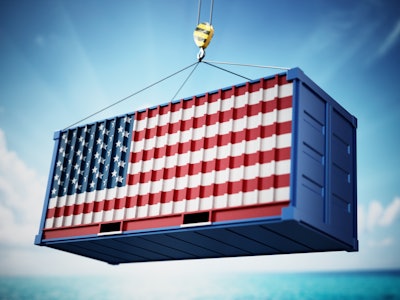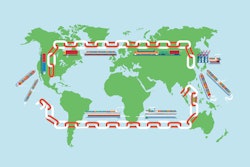
When the European Commission (EU) published a proposal for a total ban on products containing parts or materials made with forced labor on Sept. 14, it set into motion far-reaching requirements for all companies manufacturing and importing into the EU market. North American manufacturers have a lot at stake in this proposal and will be expected to provide their European customers with substantial and credible data that proves no part of their product was sourced or manufactured with forced labor.
The clock is already ticking
While the proposal moves its way through the legislative procedure, the countdown is on for manufacturers to start collecting data from suppliers to maintain EU market access. Companies that are prepared right out of the gate will be positioned to protect and increase their EU market share. In contrast, companies that wait may find themselves needing to pause their EU sales while they scramble to collect supplier data and potentially replace parts that they cannot prove are free from forced labor.
The proposed EU forced labor ban introduces new risks and costs to North American manufacturers' ability to sell products in the EU market. The proposed ban takes a risk-based approach that does not target specific regions or materials. This means that made-in-America products could be subject to investigation and penalties if they contain parts and materials from high-risk regions like China, Myanmar, Pakistan, or the Congo. It is also clear that exemptions will not be made for components that are difficult to source or replace. This blanket ban on forced labor is unique compared to other global forced labor acts like the U.S. Uyghur Forced Labor Prevention Act (UFLPA), which is regionally-focused.
Risks of delays and shortages
The UFLPA, which only regulates a small number of high-risk materials from a specific region, taught manufacturers that forced labor bans can cause sudden market shortages that hold up production for months and potentially years. When polysilicon from the Xinjiang Uyghur Autonomous Region (XUAR) was banned from the U.S. market, it caused significant disruptions in the solar power sector. Nearly every solar panel manufacturer had to rely on suppliers' data to prove their material was compliant or find a different source for this essential material.
There are now severe polysilicon shortages on the market, creating substantial delays and increased material costs. The only solar power businesses that came out unaffected were those that had already assessed their supply chain sustainability risk and could procure compliant polysilicon.
Now imagine the global impact of a total forced labor ban that is not limited by material type or region of origin. The potential for supply chain disruptions is undeniable. Companies that act now and ensure their materials are free of forced labor (or replace suppliers that present a forced labor risk) will be the winners of the coming global market shift.
Financial damage: Market loss, contract loss, product loss
The proposed regulation has a zero-tolerance policy for companies profiting from forced labor. Any products that manufacturers cannot adequately disprove forced labor concerns for will have to be destroyed or rendered inoperable to ensure they cannot be sold in other markets. There will be no way to recoup losses if products are stopped at the border and found to be lacking compliance data. Additionally, while products are being challenged and investigated by customs, they will be warehoused, with manufacturers likely footing the bill.
New risks are not just a future concern — requests for due diligence data from a company’s EU customer base can start any day now. Suppose manufacturers do not have the data available. In that case, it could create friction in their existing supplier/customer relationships, and the time required to survey their supply chain translates into production delays for their customers. Businesses that can provide deep supply chain sustainability data in advance of the regulation will be seen as more reliable and safer investments.
These issues are compounded by the deeper contract and market loss risks of non-compliance. If products are delayed at the border, increasing surveillance and scrutiny on a company’s customers, this could result in paying contract penalties or worse, total loss of contracts as EU customers seek replacements with better compliance data. The inability to provide sufficient data to prove credible due diligence can also result in loss of access to the entire EU market.
3-point action plan
Supply chain sustainability data is at the heart of this regulation; it is not enough to have a supply chain free of forced labor, companies also need defensible data to prove it.
Here is a three-point action plan to help North American manufacturers see deeper into new risks and capture the data this proposal requires:
1. Anchor forced labor within larger ESG programs
When inquiries are embedded within more extensive environmental, social and governance (ESG) programs, suppliers are often more engaged and forthcoming with information about forced labor. This may be because suppliers feel less singled out as high-risk. Surveys should cover a range of topics across the ESG spectrum as well as a range of forced labor regulations, such as the UFLPA and Section 1502 of the U.S. Dodd-Frank Act (conflict minerals).
When forced labor is treated as one part of the whole ESG picture, companies are also better equipped to meet the broader demands of investors and buyers, not just EU border control authorities. Avoid point solutions and opt for a more holistic approach.
2. Follow global guidance and best practices
Utilizing existing global standards for forced labor due diligence will support manufacturers in efficiently collecting forced labor risk data from the deepest tiers of the supply chain. These standards include the Slavery and Trafficking Risk Template (STRT), Conflict Minerals Reporting Template (CMRT), and Extended Minerals Reporting Template (EMRT).
All these templates are free to use, recognized by international regulators, and integrate with a broader supply chain ESG program. They'll also improve supplier engagement and insights by keeping things more straightforward and standardized.
3. Conduct additional supplier screening
Given the limits of questionnaires, a key element of data credibility is that companies cannot exclusively rely on supplier self-disclosed data to understand risks. There is a wealth of data in the public domain from civil society, media sources, and governments on business connections to forced labor. Additional supplier screening may be required where forced labor risks are identified to get a 360-degree understanding of risk. Some areas manufacturers should monitor for supplier mentions include beneficial ownership, denied parties lists and adverse media screening.
Act now
While the EU forced labor ban is still only a proposal, the time to act is now. If North American companies have learned anything from the UFLPA, it is that being reactive presents significant business continuity risks. Manufacturers with deep supplier due diligence data prepared before new requirements come into force can continue operations without disruption and maintain reliable access to needed materials. The EU proposed ban on forced labor in products will be more far-reaching, and the potential for supply chain disruptions and material shortages must not be ignored.















![Pros To Know 2026 [color]](https://img.sdcexec.com/mindful/acbm/workspaces/default/uploads/2025/08/prostoknow-2026-color.mduFvhpgMk.png?ar=16%3A9&auto=format%2Ccompress&bg=fff&fill-color=fff&fit=fill&h=135&q=70&w=240)


